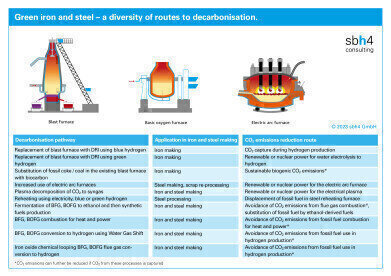Air Clean Up
Green iron and steel CO2 capture, storage, utilisation and avoidance
Aug 16 2023
Author credit: Stephen B. Harrison, sbh4 consulting
Steel forms the skeleton of skyscrapers and is the main material use to build ships, buses, cars, trains, and trucks. It is also the material used to build electricity pylons for the grid and wind turbines that make renewable power.
Finding a cost-effective alternative to steel with a low CO2-intensity and similar mechanical properties is unlikely. Per tonne of product, steel is one of the most carbon-intensive materials used in construction. So, if the case for steel is clear the future of iron and steel making can be nothing other than green.
Iron and steel making generates many thousands of tonnes of carbon dioxide (CO2) per year. The emissions predominantly come from blast furnace gas (BFG) and basic oxygen furnace gas (BOFG). These flue gases contain carbon monoxide (CO), hydrogen, and methane. Methane is a potent greenhouse gas.
To avoid pollutant gas emissions, BFG and BOFG can be flared to convert methane and CO gases into CO2 and water vapour. On some facilities, the energy from the BFG and BOFG is utilised by feeding these gases to a gas engine to generate heat and power. In this case, the exhaust from the gas engine will be rich in CO2 and water vapour but the heat and power generation will avoid the use of additional fossil fuel.
Many large and small iron and steel producers are piloting processes for decarbonisation in research programmes with emerging technology providers. For example, ArcelorMittal is using the patented DMX™ solvent-based CO2 capture technology in the 3D Project, or DMX Demonstration Dunrkirk. The Project will capture CO2 from blast furnace flue gases. CO2 is produced when coke is used to reduce iron ore to iron.
The DMX™ process and its unique solvent was innovated by IFPEN and will be commercialised by Axens. The unique aspect of this CO2 capture technology is that a CO2-rich phase of the DMX™ solvent separates from a CO2-lean phase prior to regeneration of the solvent. Only the CO2-rich phase is regenerated.
Stripping CO2 out of solvents in CO2 capture processes is highly energy intensive and is the main operating cost of CO2 capture. Since only a portion of the DMX™ solvent is required to be regenerated in this way, a reduction in energy consumption is possible when compared to traditional solvents such as diethanolamine (DEA) or monoethanolamine (MEA).
In the future, CO2 from the 3D Project will be sequestered in the future European Dunkirk-North Sea Cluster CCS scheme. Total is leading the development of the offshore CO2 storage facility. CO2 will either be transferred to the offshore storage location by ship as liquid CO2, or by pipeline as a compressed or supercritical gas.
At their Ghent blast furnace, ArcelorMittal will run a demonstration project using the LanzaTech fermentation process. This process utilises raw flue gases which are rich in CO to produce ethanol in a bioreactor. Ethanol can be used for many chemical and energy applications. For example, it is blended with gasoline at up to 10% in Europe.
Ethanol can be converted to synthetic aviation fuel (SAF) using the ethanol to jet (ETJ) process. LanzaTech’s sister company LanazaJet has developed a proprietary ETJ process that maximises the yield of aviation kerosene in the various hydrogenation and oligomerisation reactions that convert the ethanol to SAF.
Tata Steel in the UK will also deploy the LanzaTech and LanzaJet processes to capture iron and steel making flue gases from their Port Talbot facility. The project, known as DRAGON, will also use the Hummingbird® catalyst from Technip Energies (T.EN). This is a highly effective catalyst to dehydrate ethanol to ethylene. The ethylene is then oligomerised to form paraffinic hydrocarbons of between 8 and 16 carbon atoms in length. These are then blended with other aromatics to obtain the required JET specification for aviation fuel.
Electrification is also a viable decarbonisation pathway for iron and steel processing. ArcelorMittal will invest €67 million in a new electric arc furnace for their Belval site in Luxembourg.
Electric arc furnaces can be powered by renewable electricity from wind, solar and hydro schemes. They can be fed with recycled scrap steel which is less energy intensive to process than making steel in a blast furnace. Electric arc furnaces therefore avoid scope 1 and 2 CO2 emissions reduce the CO2 intensity of steel making in addition to introducing an element if circularity.
Perhaps more than any other heavy industrial sector, there is a wide diversity of decarbonisation routes for iron and steel making. The questions related to decarbonisation are not “why?” and “if?”. The questions are “where?”, “when?”, and “how?”.
Events
WEATHER • CLIMATE • WATER / EARTH OBSERVATIONS / GREEN ECONOMY
Oct 29 2024 St. Petersburg, Russia
Oct 30 2024 Hong Kong
Nov 05 2024 Toronto, Canada
Nov 06 2024 Ho Chi Minh City, Vietnam
Nov 12 2024 Valencia, Spain













